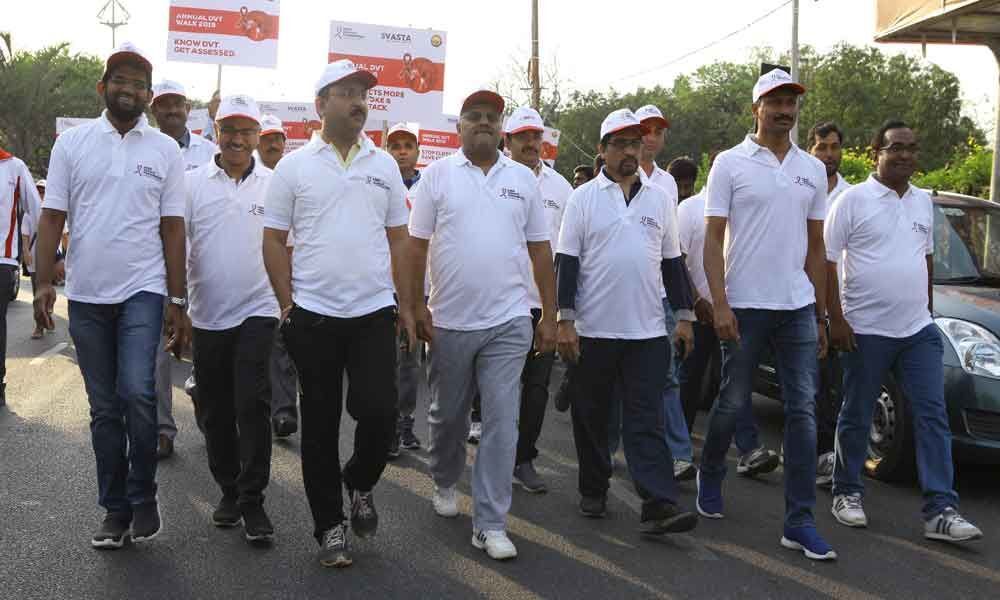Live
- They always want me to win, and now I feel lucky to have been offered a story like ‘Zebra’: Satyadev Kancharana
- ‘Democracy first, humanity first’: PM Modi in Guyana's parliament on two countries' similarities
- PKL Season 11: Telugu Titans register third straight win to top standings
- Is Pollution Contributing to Your COPD?
- NASA Unveils Underwater Robots for Exploring Jupiter's Moons
- Additional Central forces arrive in violence-hit Manipur
- AR Rahman and Saira Banu’s Divorce: Legal Insights into Common Issues in Bollywood Marriages
- 82.7 pc work completed in HPCL Rajasthan Refinery area: official
- Curfew relaxation extended in 5 Manipur districts on Friday
- Tab scam prompts Bengal govt to adopt caution over fund disbursement
Just In
Need for greater focus on Deep Vein Thrombosis-related issues


Vascular society of India, in association with KIMS Hospitals, conducted the second edition of the ‘DVT awareness walk 2019’ to spread awareness about early detection and prevention of deep vein thrombosis on Sunday at 6.30 am from KBR Park.
Jubilee Hills: Vascular society of India, in association with KIMS Hospitals, conducted the second edition of the 'DVT awareness walk 2019' to spread awareness about early detection and prevention of deep vein thrombosis on Sunday at 6.30 am from KBR Park. Additional DGP (law and order) Jitender has flagged off the walk. Many vascular surgeons of the city and major corporate hospitals came together and joined the cause. Around 500 doctors, paramedical staff and general public attended the walk.
"March is Deep-Vein Thrombosis (DVT) awareness month, and so we began a public health initiative aimed at raising awareness of this commonly occurring medical condition and its potentially fatal complication, pulmonary embolism. We can increase awareness and save lives," said Dr Narendranadh Meda, consultant vascular surgeon at KIMS Hospitals.
"A study conducted in South India showed incidence of DVT in 17 every 10,000 people. However, the incidence increases to 54% in high risk groups, especially post trauma and hip and knee surgery, cancer patients," he added.
After the flag off, Jitender said, "There is a tremendous need for greater awareness and education about DVT-related issues. The walk is to advocate the importance of health and educating the public about risk factors, symptoms and need of health screenings. Events like these will help educate public about the importance of the disease and get treated in the right away. I am glad to be a part of this walk."
It is estimated that 2 million people are affected annually by DVT, more commonly known as blood clots, and yet most, about 74 percent, have little or no awareness of DVT, according to a survey by the American Public Health Association.
Blood clot is a potentially serious condition because it could cause pulmonary thromboembolism, which is fatal. It is a condition in which a blood clot develops in the deep veins, most commonly in the lower extremities. A part of the clot can break off and travel to the lungs, causing a Pulmonary Embolism (PE), which can be life threatening. It is important to have awareness about the nature of disease and its prevention to avoid fatal complications like PE. It is estimated that about 15% of overall sudden deaths are attributed to pulmonary embolism.
Venous ThromboEmbolism (VTE) is often recurrent, and the long-term complications, such as post-thrombotic syndrome post DVT or chronic thrombo-embolic pulmonary hypertension post PE are frequent.
Who is at risk?
People above 40 years old and obese are more vulnerable to the disease. The symptoms for DVT are conditions causing blood stagnation in the deep veins, (ii) if the blood is unusually "thick" or "sticky" (as in various hyper coagulable states) and (iii) following an injury to the internal lining of a vein.
- Such conditions are:
- prolonged immobilization (during a hospital admission, a long travel by airplane or coach – the "economy class syndrome" etc)
- Previous episode of DVT, family history of DVT
- Thrombophilia
- Malignancy (cancer) or previous malignancy
- Operation or trauma, especially of hips, knees, abdomen or chest
- myocardial infarction, stroke, congestive heart failure, inflammatory bowel disease
Also increased risk among women who take oestrogens (contraceptive pills, hormone replacement therapy) and pregnant and post delivery. Pregnant woman are six times more likely to get life-threatening blood clots.
Preventing blood clots
- If one falls into any of the high risk groups, it is better to use prophylactic measures, such as using compression stocking, pneumatic calf pumps or prophylactic use of blood thinners.
- One should avoid standing for long periods of time and having a sedentary life. If you need to remain seated, don't sit with the legs bent for hours, but stretch your legs out from time to time, and move your feet up and down at the ankles or stand up and stretch your legs.
- If you are planning to have surgery – appropriate measures of prophylaxis should be taken by your surgeon depending upon your DVT risk. These may include anticoagulation, anti-thromboembolism stockings, early ambulation etc.
- If you are planning to travel – do not wear tight clothes. Move your feet up and down at the ankles, stretch your legs and go for a walk up and down the aisle. Do not get dehydrated: drink plenty of water. If you are a person of high risk for DVT, ask your doctor if you need to use compression stockings during your travel or even have anticoagulant injections.
- Last but not the least is to quit smoking.

© 2024 Hyderabad Media House Limited/The Hans India. All rights reserved. Powered by hocalwire.com






